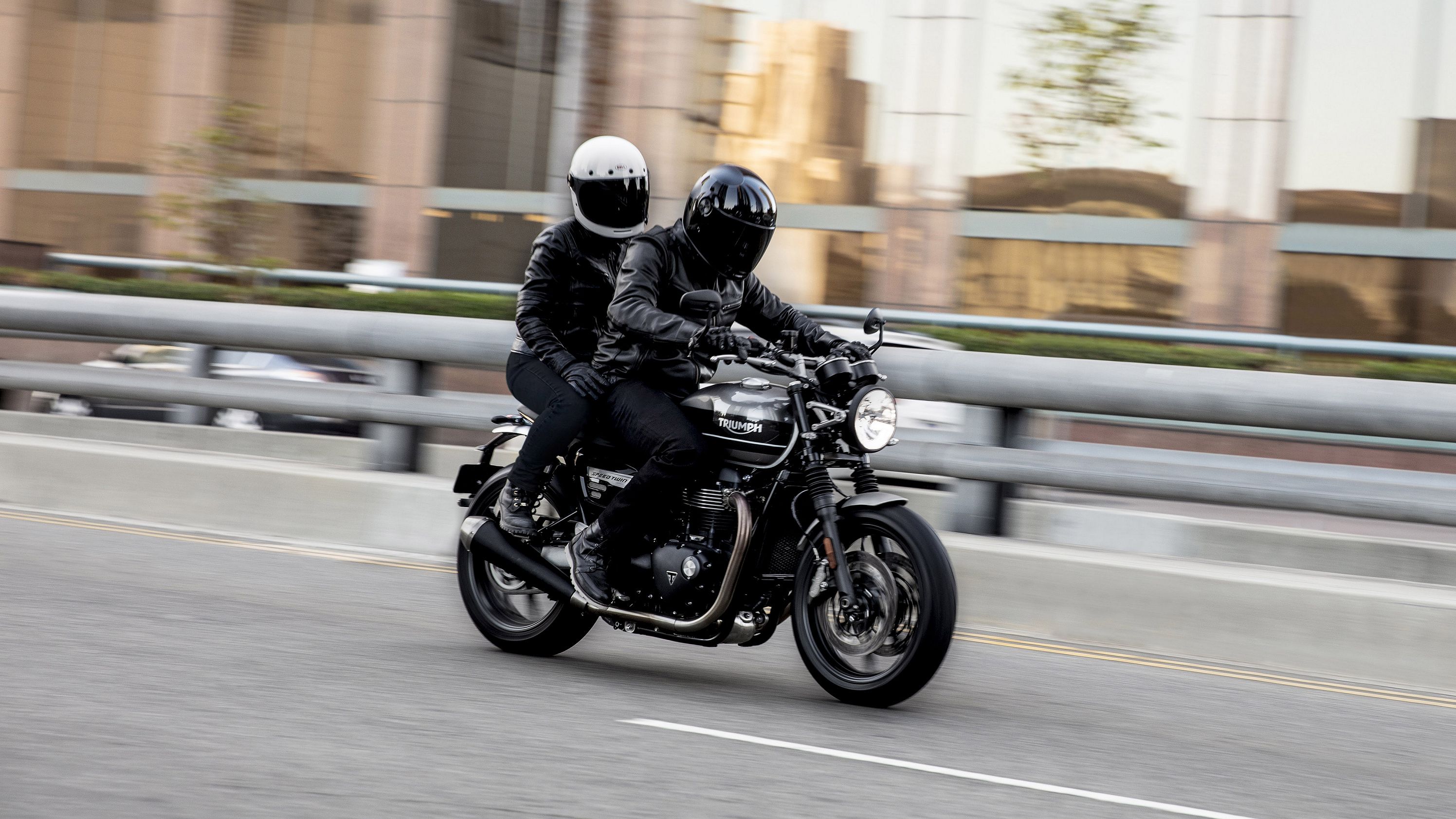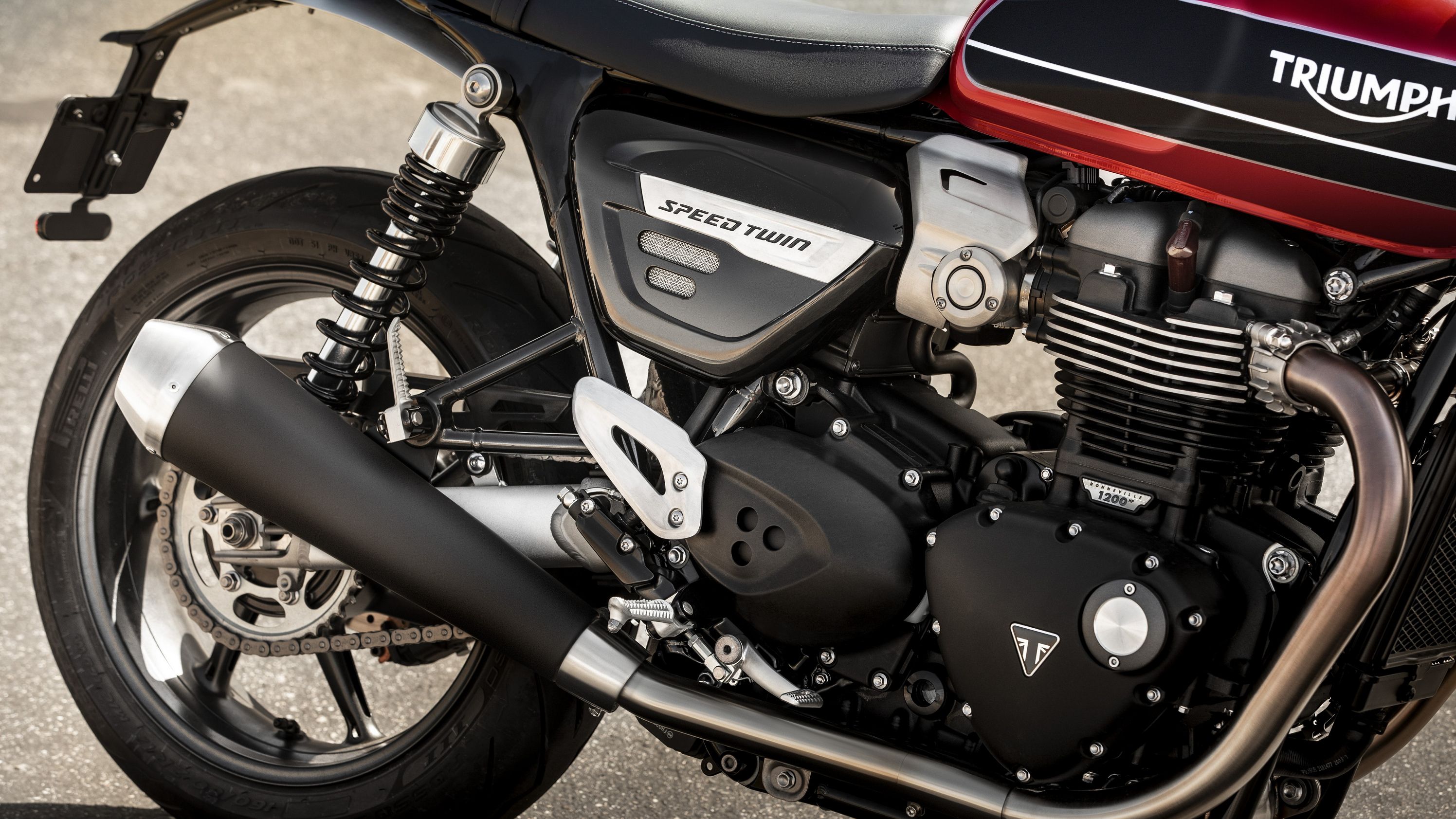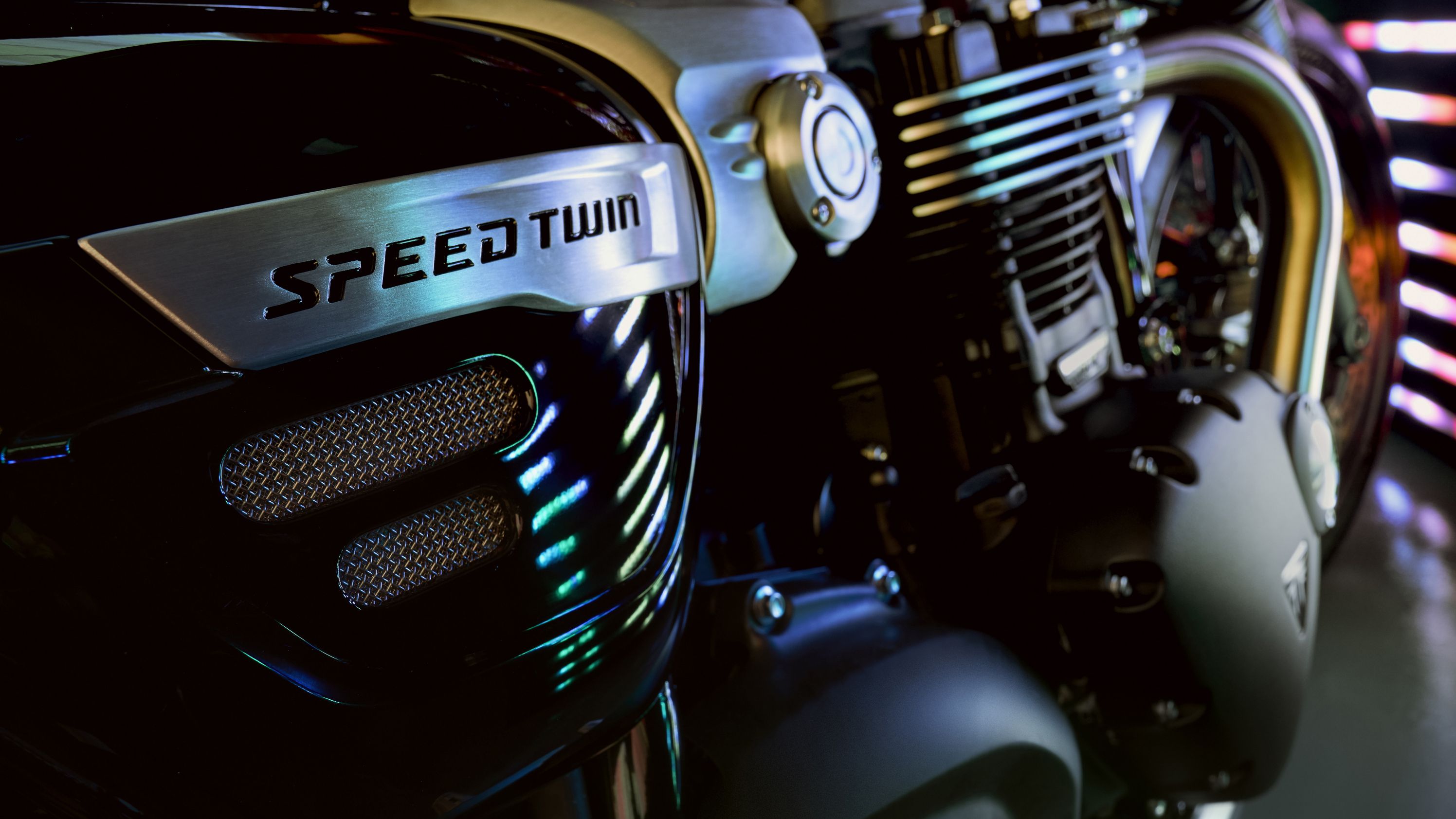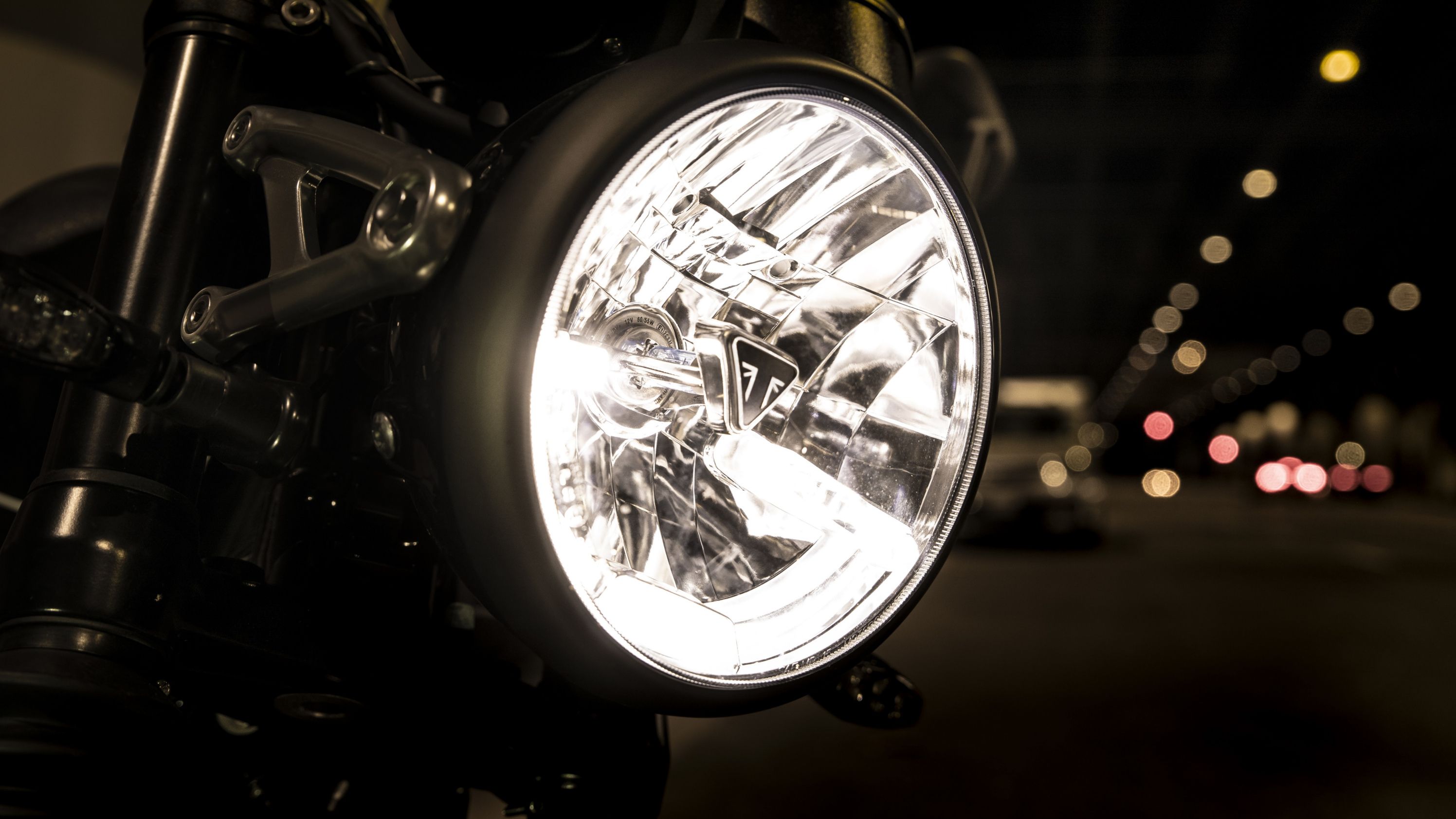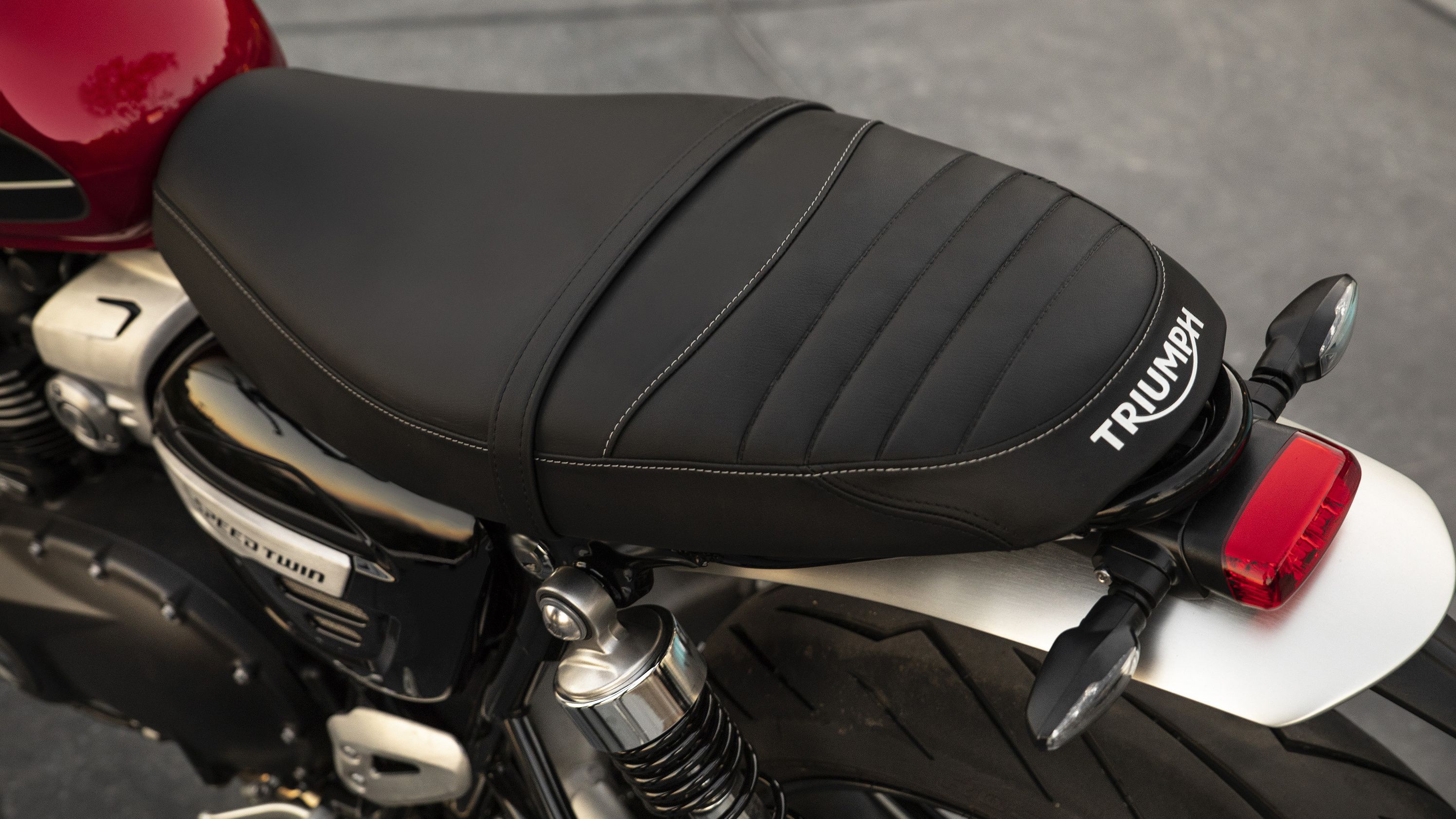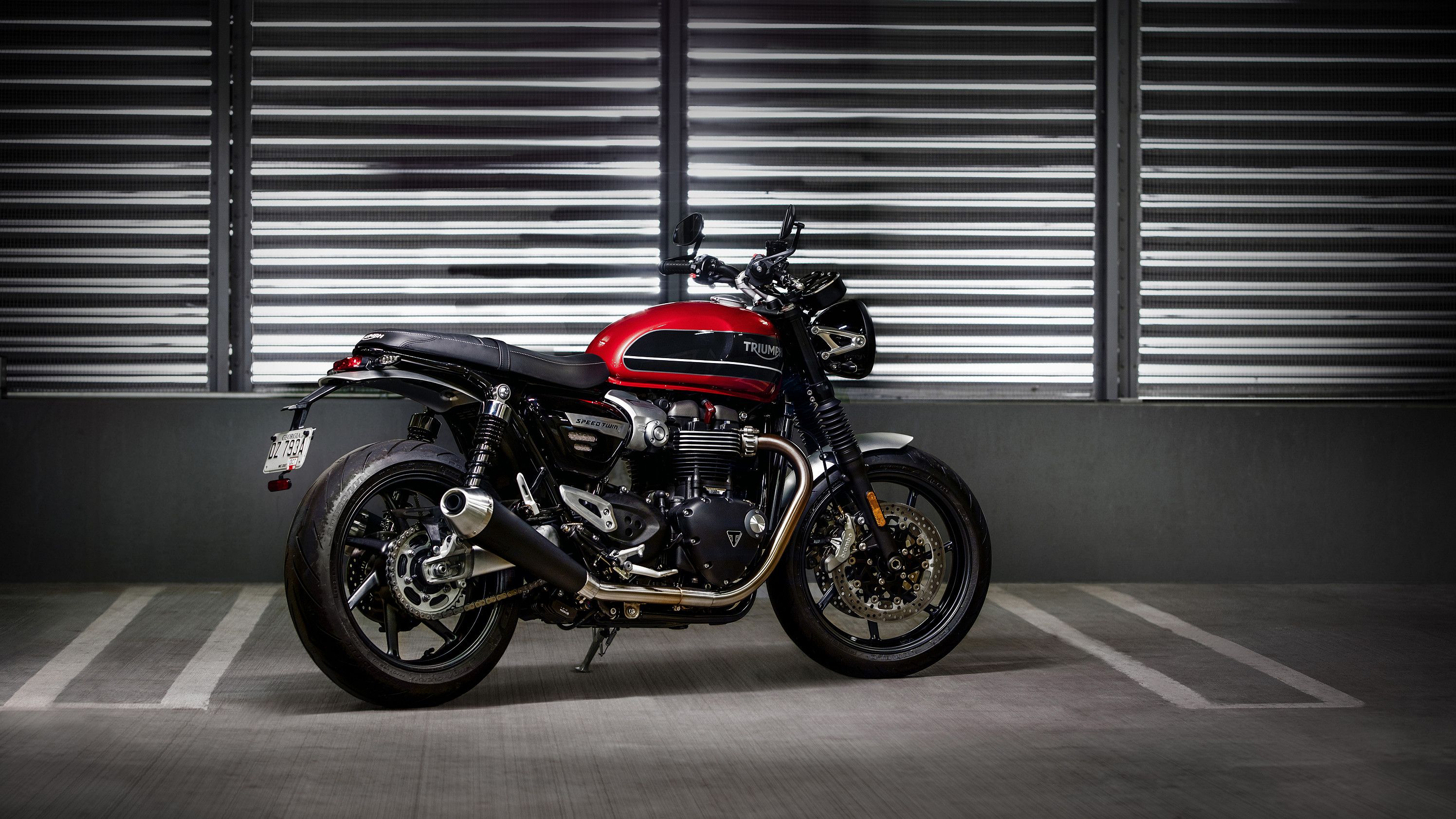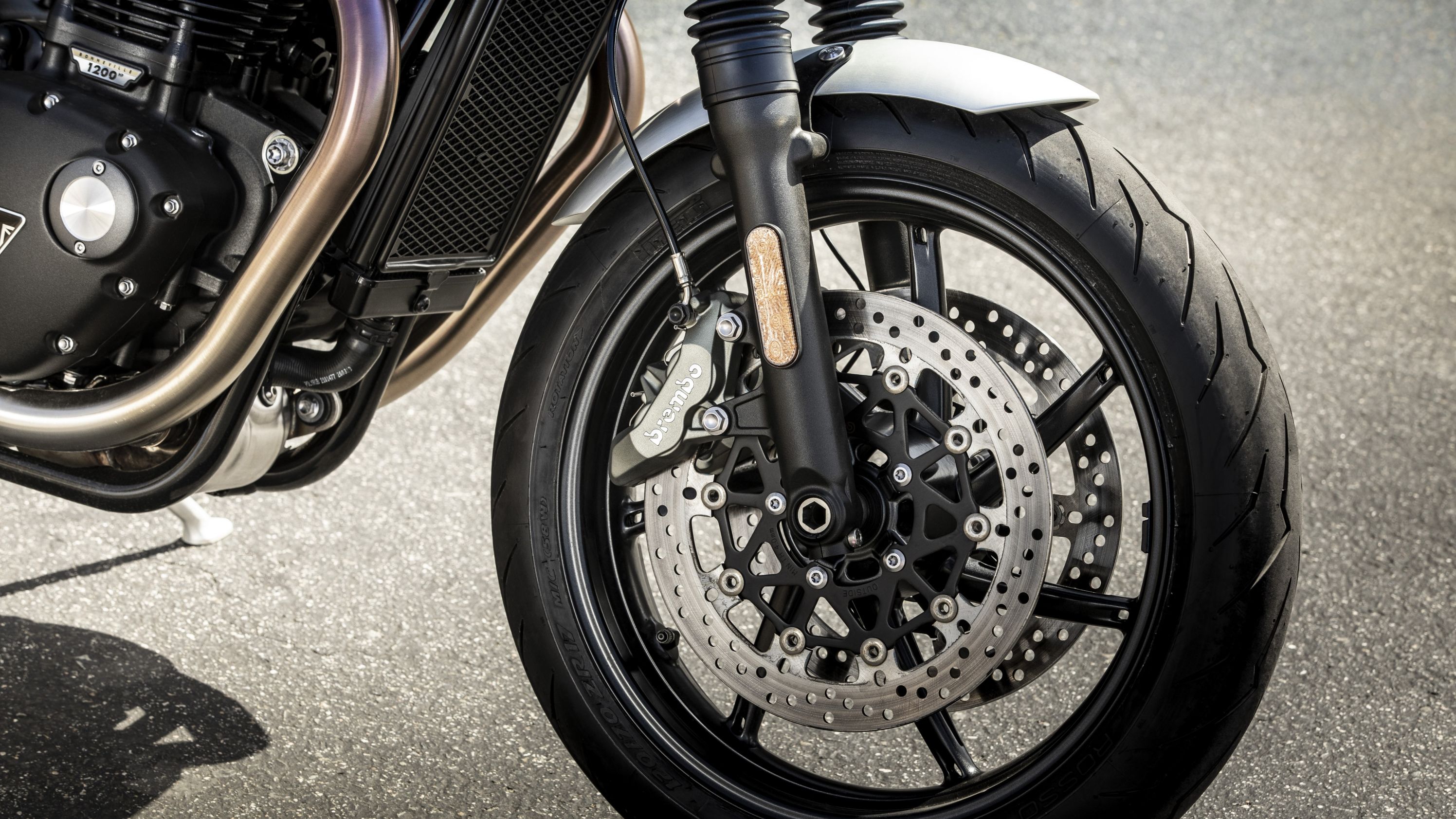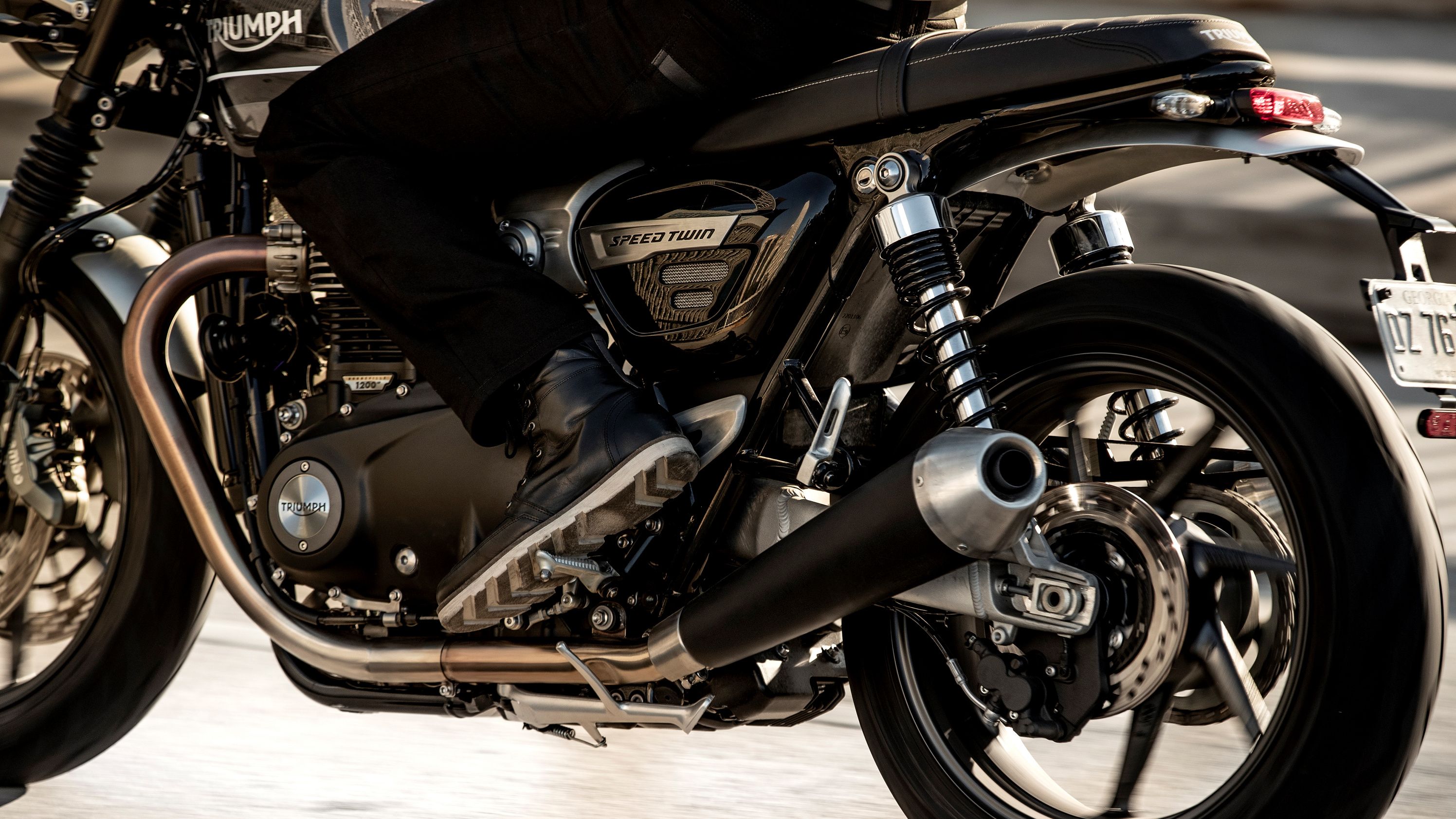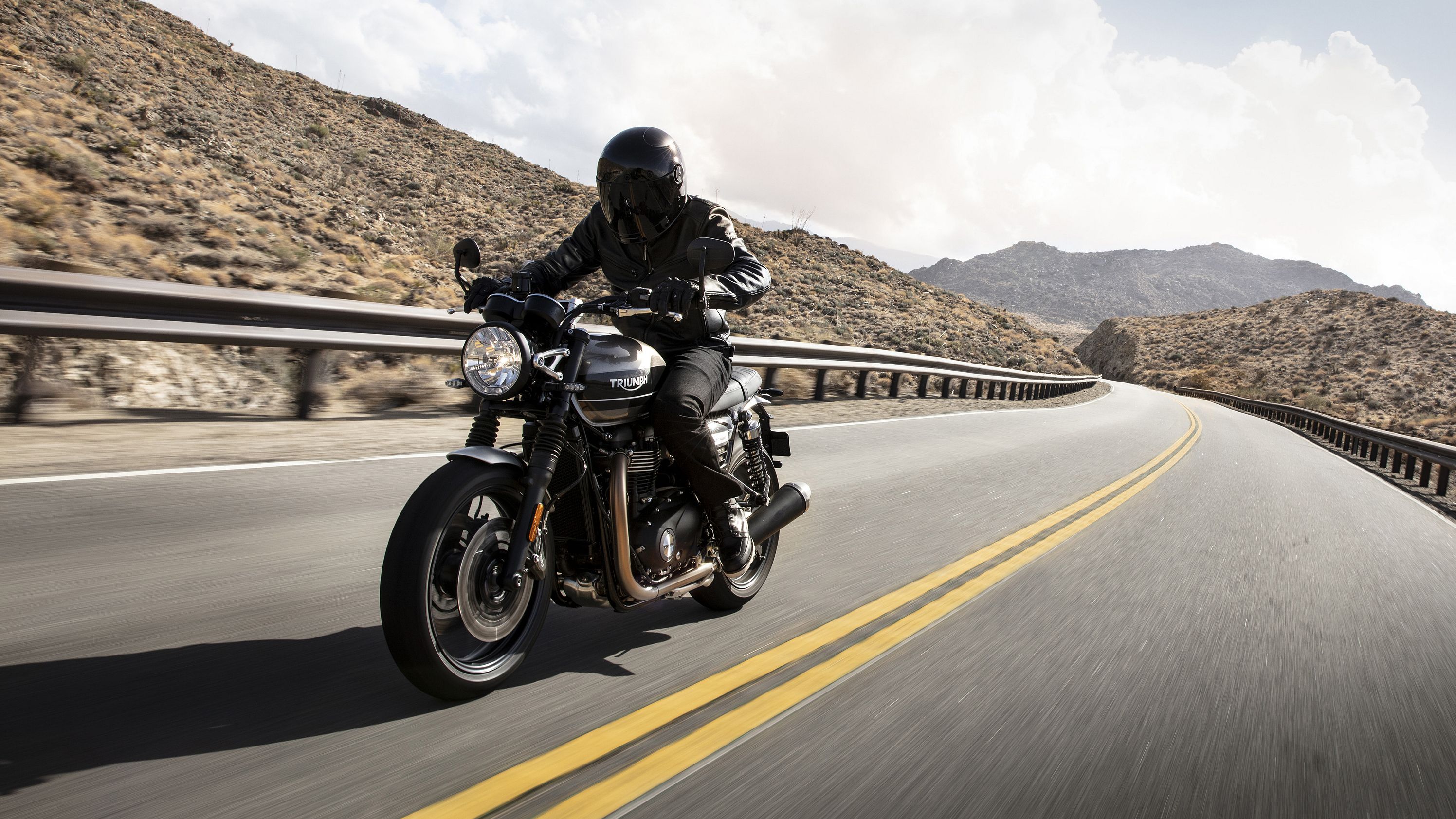Triumph expanded its “Modern Classics” lineup ahead of MY2019 with the new-in-'19 Speed Twin as a tribute piece paying visual homage with all the modern-ness you'd expect tucked away under the hood and out of sight. The result is a clean-looking classic with gobs of retro appeal, and that's an important detail because the newest generation of riders has shown themselves to have an interest in the old-school looks, much to their credit.
2022 Triumph Speed Twin Performance and Capability
Power comes from a “Thruxton-tuned,” parallel-twin engine that looks very much like the Twingles of old except it rocks a 27 degree crank-journal offset giving it a lope the old 180-degree engines lacked.
The Speed Twin engine has polished cooling-fin edges that probably do draw off some waste heat, but it's the water jacket and radiator that does the heavy lifting there. Thank goodness the radiator all but vanishes against the rest of the black paint so it doesn't ruin the image the factory was going for.
A single over-head cam times the poppets that come four to a cylinder to keep the top end relatively uncomplicated. Bore and stroke measure out at 97.6 mm and 80 mm, respectively, for a total displacement of 1,200 cc on the nose and a moderately warm, 11-to-1 compression ratio.
While the realist in me understands and supports the use of ride-by-wire, fuel-injected, throttle-body induction control, the purist can't understand why Triumph didn't use its really cool throttle bodies that look just like the old mechanical-slide carbs. I mean, if there was a bike other than the bobbers that need that item, it's this one.
Power is respectable and the Triumph Speed Twin produces 96 horsepower at 6,750 rpm and 82.6 pound-feet that tops out at 4,950 rpm. The engine control incorporates the balance of the fandanglery with a trio of riding modes -- Sport, Road, and Rain -- and switchable traction control to help you manage all that power.
A slipper clutch couples engine power to the six-speed transmission. Not only does it give some anti-hop protection to the rear wheel, it also makes for a relatively light pull weight at the clutch lever.
|
Engine & Drivetrain |
|
|
Engine: |
Liquid-cooled, 8 valve, SOHC, 270° crank angle parallel-twin |
|
Displacement: |
1,200 cc |
|
Bore x Stroke: |
97.6 mm x 80 mm |
|
Compression: |
11.0 :1 |
|
Max Power EC: |
96 hp (72 kW) @ 6,750 rpm |
|
Max Torque EC: |
82.6 lb-ft (112 Nm) @ 4,950 rpm |
|
Fuel System: |
Multi-point, sequential electronic fuel injection |
|
Exhaust: |
Brushed 2-into-2 exhaust system with twin brushed silencers |
|
Final Drive: |
X ring chain |
|
Clutch: |
Wet, multi-plate assist clutch |
|
Gearbox: |
6-speed |
Design
No doubt, Triumph has some deep roots indeed, and the factory took advantage of that when designing the new Speed Twin. The factory went all the way back to 1938 and the original Speed Twin roadster for the inspiration we see reflected here in the finished product. Reduced to the essentials, the Roadster has an old-school custom vibe that serves as the icing on the cake as far as I'm concerned.
Right out of the gate, it starts with blackout treatment at the wheels and spreads to nearly all possible points in between. Everything from the standard front forks -- sliders, gaiters, and tubes -- to the cyclops headlight can and dual analog clocks for the instrumentation, takes on an achromatic finish. All except the heavily bobbed front fender finished bright and cut down to reduce unsprung weight at the front axle.
A 3.7-gallon teardrop tank strikes the appropriate figure in profile, plus it sports the good old knee pockets that pull the rider's legs into the bike to reduce drag. Normally, I'd gig a builder for using a flange-style tank, but in this case, it just adds to the retro vibe.
The tank drops off to a bench seat that has only a grab strap to serve as the break between pilot and pillion. This gives you room to slide fore and aft as needed for body English or whatever.
A sparse subframe keeps the rear end clean with a taillight nestled between the tip of the tail and the chopped-back rear fender. Like the rest of the lights on this ride, they're LEDs so you can count on them to make you highly visible, even in daylight.
Standoff winkers brace the taillight, and the license plate acts as a fender-extender from its position on the short mudguard. Some might call it austere, but I like the clean look and the subtle, old-school performance hacks. I'd point out that this is a tribute piece, so there's that.
|
Triumph Speed Twin Specs |
|
|
Width Handlebars: |
29.9 in (760 mm) |
|
Height Without Mirror: |
43.7 in (1,110 mm) |
|
Seat Height: |
31.8 in (807 mm) |
|
Wheelbase: |
56.3 in (1,430 mm) |
|
Dry Weight: |
432 lbs (196 kg) |
|
Tank Capacity: |
3.8 US gal (14.5 l) |
Chassis
Tubular-steel members make up the bulk of the frame on the Speed Twin with an aluminum cradle to support the engine and keep weight down to 432-pounds, dry. I was a little surprised at the steering geometry, if I'm honest. It measures in with a super-short 22.8-degree rake with 3.68-inches of trail over a 56.3-inch wheelbase. To call it eager in the corners would be an exercise in understatement, but it's cool 'cause the original was a performance-oriented machine, as well.
The cast-aluminum wheels are symmetrical fore-and-aft at 17-inches around with a 120/70 Pirelli Diablo Rosso hoop up front and 160/60 out back. Dual, four-piston Brembo calipers grab twin, 305 mm discs to do the bulk of the work with a 220 mm disc and twin-pot Nissin anchor out back mainly to keep your rear-end where it belongs; behind you. ABS comes stock, like it or not, and I'm a little surprised that the anti-lock feature isn't switchable, but what are ya' gonna' do?
An aluminum swingarm articulates the rear wheel with a pair of coil-over shocks on suspension duty. Up front, a pair of 41 mm, cartridge-style forks take care of business, and while both ends rock 4.72-inches of travel, the rear end has the only suspension tweak with an adjustable preload feature.
Overall, the chassis is fairly vanilla. Not only does that uncomplicate matters, but it helps to keep the final price to the consumer down.
|
Chassis & Suspension |
|
|
Frame: |
Tubular steel with aluminum cradle |
|
Swingarm: |
Twin-sided, aluminum |
|
Front Suspension: |
41 mm cartridge forks, 4.7 in (120 mm) travel |
|
Rear Suspension: |
Twin shocks with adjustable preload, 4.7 in (120 mm) rear wheel travel |
|
Rake: |
22.8 º |
|
Trail: |
3.68 in (93.5 mm) |
|
Front Brakes: |
Twin 305 mm discs, Brembo 4-piston fixed calipers, ABS |
|
Rear Brakes: |
Single 220 mm disc, Nissin 2-piston floating caliper, ABS |
|
Front Wheel: |
Cast aluminum alloy, 17 x 3.5 in |
|
Rear Wheel: |
Cast aluminum alloy, 17 x 5.0 in |
|
Front Tire: |
120/70 ZR17 |
|
Rear Tire: |
160/60 ZR17 |
2022 Triumph Speed Twin Price
The 2022 Triumph Speed Twin has an MSRP of $12,595, which is not a bad price for the performance and electronic wizardry included in the package. The Speed Twin comes in Jet Black, or you can have your choice of colors Red Hopper or Matt Storm Grey for $300 more.
|
Pricing & Equipment |
|
|
Instrument Display and Functions: |
LCD multi-functional instrument pack with analog speedometer, analog tachometer, gear position indicator, fuel gauge, range-to-empty indication, service indicator, clock, trip computer, scroll and mode buttons on handlebars, heated grip ready, fuel consumption display, traction control status and throttle mode display. TPMS ready. |
|
Color: |
Jet Black, Red Hopper, Matt Storm Grey |
|
Price: |
$12,595, Color: $12,895 |
Triumph Speed Twin Competitors
|
|
left> |
right> |
The café-tastic W800 Café from Kawasaki just based on looks alone was tempting, but I decided the displacement difference was just too great to justify. Then I remembered Honda's tribute piece, and I was set.
Honda CB1100 EX
|
|
center> |
The “CB” just does it for me, lookswise. I love the dated panache and the old-school performance vibe, even if Honda targeted a much more recent vintage for its inspiration. It's a true UJM that we'd just call a “standard” nowadays. Honda even chucked in some knee pockets ahead of a faux tuck-and-roll bench seat to put these rides roughly on-par with one another in the looks department.
Rather than relying on blackout paint to go for a custom feel, Honda instead left lots of bits finished bright so there's no shortage of chrome/polished bling, and it sends the CB out with adjustable spring preload at both ends for a bit of an advantage in the suspension. Both rock dual front brakes and ABS, so the brakes are a wash as well.
For the engine, Honda springs for a 1,140 cc plant that falls just short of the Trumpet, and that carries over directly into the power numbers. The CB's four-cylinder mill generates 49 horsepower and 67 pound-feet of torque against 96/82, and that's a significant difference in favor of the Brit.
At the checkout it looks a photo finish; Honda asks $12,199 for its CB1100 EX. With the Speed Twin coming in at the same price, it's a lot more bike for the buck, not only 'cause of the power, but because the Honda has bupkis for higher electronics.
He Said
“What a snazzy little ride. Maybe not so little, more like mid-size, though there was a time that 1,200 cc would have been considered a large engine. I like the looks and the 'lectronics, the performance is on point, now let's see where the price tag falls.”
She Said
My wife and fellow motorcycle writer, Allyn Hinton, says, “This bike is all about performance in a classic style. I love the retro vibe. The instrument clocks are new and give it an old-school look, but the modern electronics are there in the way of rider modes, traction control, and ABS. According to the factory, the Speed Twin is all about the best parts from each of the 'Modern Classics' models rolled into one with a little bit extra for the thrill of it.”
Further Reading
Read more Triumph news.


